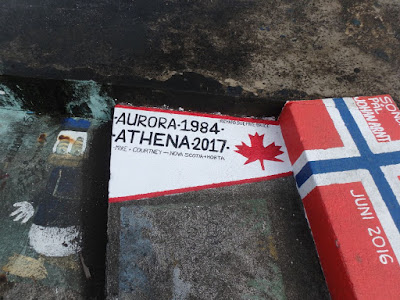Cristo Rei - statue of Christ the King in thanks for Portugal (astutely) avoiding the Second World War - overlooks the Tagus as we arrive in Lisbon.
At the ship’s bow, I can see where my father’s flying boat landed after the flight from Bermuda.
From Dad’s wartime notes: ‘… soon after 1:30 P.M. … we saw the mountains of Portugal coming into sight. We were soon flying up the Tagus with low-lying ground to our right and beautiful mountain scenery to our left. The sides of the foothills were dotted with brightly-coloured villas which are used as summer homes by the wealthier people of Lisbon.
Soon Lisbon came into sight on our left and the plane commenced lose height. We passed the city and dropped towards some sailing boats which were anchored near the shore. We went into a steep bank above the boats, seeming almost to touch the tops of their masts, straightened out, and came down to a perfect landing about half a mile from the shore. We had flown the Atlantic’.
‘Very soon a motor launch came alongside and we were pulled into the jetty. When we had tied up, some Portuguese officials came aboard and, after a short while, we were allowed ashore … The customs officials examined our belongings very carefully and purloined a carton of cigarettes which Brigadier Hardy (my note: another British Army officer) was carrying in his bag’.
The eggs bound for London passed inspection, but officials were doubtless delighted to supplement their wages - likely not for the first time - with marketable American cigarettes. They represented a regime doing rather nicely out of the war. Not only is it largely forgotten Portugal embraced fascism, but that the country adroitly juggled Axis and Allies, emerging in 1945 better off than in 1939.
That it did so was mainly due to António Salazar, seen making a speech and then, on the left, giving the fascist salute. Salazar was dictator from 1932 to 1968.
As with Mussolini’s Fascist Italy, much of its teaching evoked the glory days of empire, a glory supposedly to be regained under the state’s unfailing direction.
Unlike Dad, I exit the port unhindered by pilfering officials ...
... making my first stop in Lisbon at the impressive Praça do Comércio bounded by government buildings and cafes.
Here Salazar gave a 1941 speech on national unity and neutrality. This was wartime Portugal’s largest political rally and included fourteen (!) military bands.
Not far from where Salazar extolled the regime’s accomplishments, a new museum covers the decades of dictatorship. The Museu Do Aljube was once an infamous prison.
Aljube is of Arab origin and means dungeon. The building was used as a prison since the Moorish occupation and, from 1928 to 1965, held political prisoners.
Jailers, torturers and victims could see Lisbon’s cathedral. One wonders what went through their heads with an ostensible symbol of Christian mercy just across the street. More to the point, one wonders how the Church justified what went on in the prison. Actually, we know. Both Church and State united in combating the merest semblance of opposition, a struggle against political heresies, generally (and conveniently) equated with ‘Godless communism’.
The secret police headquarters survives in Lisbon’s centre. A plaque commemorates “ ... the thousands of men and women ... interrogated and tortured during the Estado Novo regime. Many of them died as a result of their ordeal.”
The old guard made a last stand here in 1974 when protesters surrounded the building and police opened fire.
They claimed the regime’s last victims, killing four and wounding several.
In the world’s odd way, the building has been converted into fashionable apartments, offices and stores.
Posh refrigerators - one with Jimi Hendrix - are displayed rather as if the Gestapo’s old haunts were being used to sell expensive coffee makers.
=======================================================
In the next post, I’ll tour wartime Lisbon with my father, city of light in blackout Europe, of limited rationing, of refugees, spies and glimpses of the enemy.































































